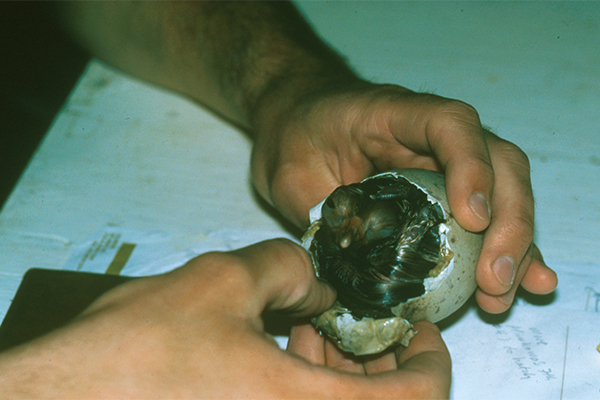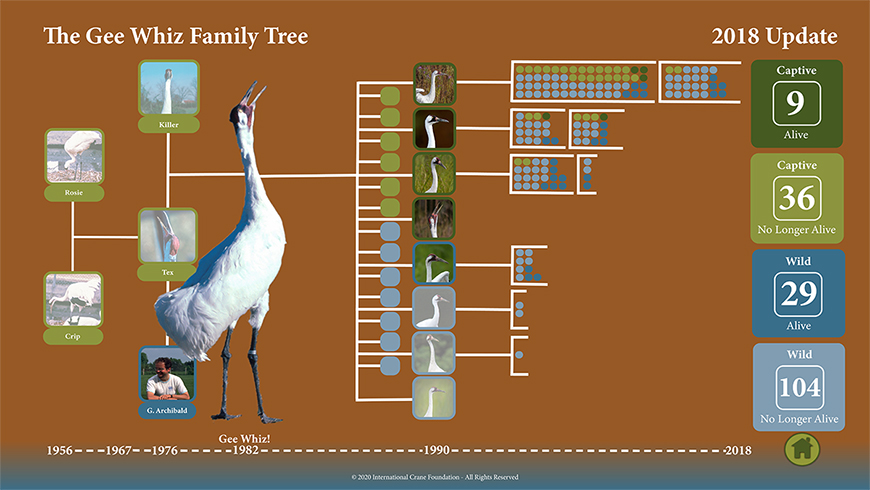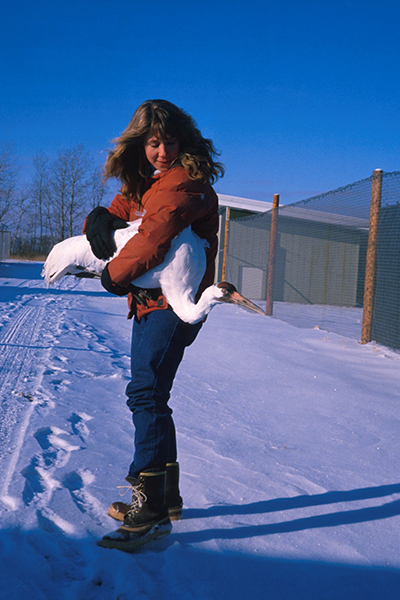
Gee Whiz, a Whooping Crane extremely important to crane reintroduction, passed away recently in Crane City, our breeding facility. He lived for 38 years and nine months.
A miracle from inception, Gee Whiz was the first Whooping Crane to hatch at the International Crane Foundation and only the fifth Whooping Crane at our headquarters. He also was the only living son of Tex, a legendary Whooping Crane made famous by her closest friend, International Crane Foundation Co-founder Dr. George Archibald. The world learned about Tex when George appeared on The Tonight Show Starring Johnny Carson in 1982 to tell their inspiring story of Whooping Crane reintroduction perseverance. George Archibald danced with Tex to induce her to lay eggs.
“I worked with Tex for seven years before a successful hatch of Gee Whiz in 1982,” recalled International Crane Foundation Co-founder George Archibald. “I was 36 when Gee Whiz hatched and 74 when he died. During those intervening years, Gee Whiz, with the assistance of the International Crane Foundation’s excellent staff, produced many offspring.
“During those years, I spent much of my time in Asia and Africa helping other cranes,” George continued. “When home, I visited Gee Whiz from time to time. He was perhaps the most aggressive of our cranes and greeted everyone, including his stepdad, with threat postures and loud calls. He had amazing vitality.”
To keep Gee Whiz’s legacy alive, please consider making a gift supporting our Whooping Crane reintroduction projects. With your gift we will continue establishing new, wild Whooping Crane populations in North America. Your generosity will strengthen our efforts to continue breeding, raising, releasing and monitoring Whooping Cranes in the wild. Gifts can be made here.
Gee Whiz hatched June of 1982 at the International Crane Foundation through an artificial insemination (AI) process from semen sent to the International Crane Foundation from the USGS Patuxent Wildlife Research Center in Maryland. He is named after Dr. George Gee, who worked at Patuxent and collected the semen used for AI.

A tenacious bird, Gee Whiz beat the odds, thanks to the innovative care of dedicated staff. His egg was underweight, and he was very weak at hatch. Gee Whiz required a lot of human intervention to gain strength and develop into a strong chick.
A resident of the International Crane Foundation his whole life, Gee Whiz is best known for being a father of Whooping Crane conservation, having been the patriarch of a family of 178 genetically diverse Whooping Cranes through four decades. For many years, Gee Whiz shared his pen with his mate Oobleck.

Gee Whiz’s paternal efforts helped bring back one of the most endangered bird families on the planet, from numbers as low as 14 in the 1940s to more than 800 birds today.
Gee Whiz’s contributions to Whooping Crane Conservation ensure Whooping Cranes remain on the landscape, especially in the Eastern Flyway, the home to many of Gee Whiz’s grandchildren and great-grandchildren. They carry on the battle of Whooping Crane conservation, helping guarantee the survival of these beautiful, charismatic and tenacious birds.
Some of these offspring include a female Whooping Crane, who was reintroduced to Wisconsin’s landscape. Along with her mate, she made her home on a cranberry farm 60 miles north of Baraboo, Wisconsin. We refer to this pair as 5-11 and 12-11. For several years, the pair only produced infertile eggs. But around 2014, a researcher discovered their first chick.

“5-11 and 12-11 have fledged two chicks, W1-18 and W1-19, both of which are still alive. The pair almost fledged twins in 2020,” said Curator of Birds Kim Boardman. Another male descendant of Gee Whiz, 4-12, is part of the “Royal Couple,” the first pair to nest at White River Marsh in Wisconsin.
Two other offspring of Gee Whiz, 4-17 and 6-17, were part of a trio of Whooping Cranes observed last spring by George, as the triad made their home about five miles from the International Crane Foundation. More information about this triad is available through our Travel’s With George blog series.
Gee Whiz was known for his bigger than life personality. He was fiercely territorial of his house and enclosure at the foundation, requiring staff to have fast reflexes when working in his proximity. Kim recalls, “As the only offspring of Tex, his genetics were highly valuable, and much time was spent performing AI on Gee Whiz in the spring.

“Everyone dreaded having to handle Gee Whiz for AI because he was an expert at finding the top edge of handlers’ boots and pecking or biting the handlers’ calves just above their boots or nipped at their fingers as they stroked his legs. To say he ‘left his mark’ was an understatement,” she continued.
